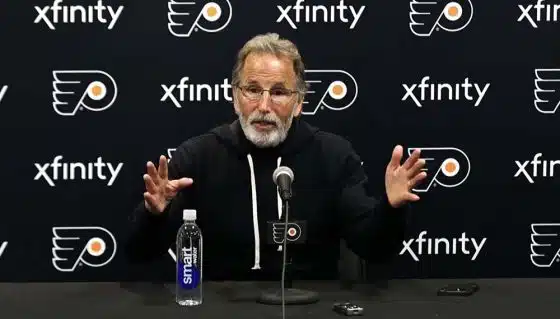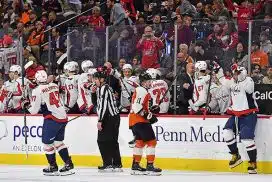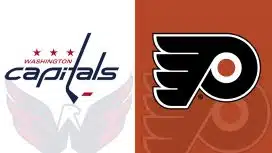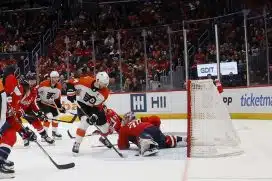By Kevin Durso, Sports Talk Philly editor
The Stanley Cup Final has been over for more than 24 hours now. Obviously, it’s not the ending fans in Philadelphia were looking for, but it speaks volumes to win back-to-back titles in any sport, especially one as grueling as hockey can be.
This year’s Stanley Cup Final and the playoffs as a whole really proved several things. Here are five things we learned from the Stanley Cup Final.
The Importance of Development
This one goes both ways, and I highlighted this some before the Final began. Both teams had a knack for developing players to construct a team capable of reaching the Final. But the Penguins in particular have shown the importance of Ron Hextall’s next step in the rebuilding of the team.
It starts with drafting players or acquiring some upstart, motivated kids as undrafted free agents and bringing them all the way to the NHL. On the 2015-16 roster, the Penguins had their usual suspects, but also a number of kids — Conor Sheary, Tom Kuhnhackl, Bryan Rust, Scott Wilson, Oskar Sundqvist, Daniel Sprong and of course, Matt Murray. On this season’s roster, it was a lot of the same — Sheary and Rust and Wilson were all key factors, as was Murray — but add in Carter Rowney, Josh Archibald, Cameron Gaunce and standout Jake Guentzel.
You start to ask yourself, where do they find these kids?
The Flyers are in the process of building a similar pipeline. They have a wealth of prospects. The next step is to develop them so they are ready for the call, whenever that may come.
Guentzel is the perfect example. He played 40 NHL games in the regular season, scoring 16 goals and adding 17 assists for 33 points. In the AHL, playing in 33 games, he scored 21 goals and added 21 assists for 42 points. He followed that up with 13 goals and eight assists in the playoffs in Pittsburgh’s 25 games. If you’re keeping track, that’s 98 games played this season with a total of 50 goals and 46 assists for 96 points.
Part of that is the product of playing with generational superstars like Sidney Crosby and Evgeni Malkin, but Guentzel got it done at two levels in more games than any professional player had this season. He’s now going to get his name on the Stanley Cup as a rookie, and had an argument for the Conn Smythe Trophy. But that went to our next topic of conversation…
Face it, Crosby’s the Best in the World
Love him or hate him — and in Philadelphia, we know which side they’re on — Sidney Crosby is the best player in the world and the best player of this era.
No player will unseat Wayne Gretzky as the greatest and it’s hard to look at Gordie Howe or Mario Lemieux or Jaromir Jagr and say they don’t define an era as well.
But since 2005, this has been Crosby’s show. The trophy case provides all the explanation you would ever need — three Stanley Cups, a three-time Conn Smythe winner, a two-time Art Ross Trophy winner, a two-time Maurice Richard Trophy winner, a three-time Ted Lindsay Award winner, two Gold Medals in the 2010 and 2014 Winter Olympics and a World Cup of Hockey Championship.
Within roughly the past year, Crosby has won two Stanley Cups, been named the Conn Smythe Trophy winner both times and won the World Cup of Hockey Championship with Canada.
Add to the resume that he has done all that, and he’s just 29, even as a 12-year NHL veteran.
More than that, he’s still the player that demands the attention on the ice, commands a game, dominates with the lethal combination of speed and skill that, at his level, comes along once in a lifetime. A lot of people hate him because he’s so good. The “Crosby sucks” chants still ring out in many arenas in the NHL. And it’s only made him elevate his game even higher to prove them wrong again.
When Crosby took home the Conn Smythe last year, I didn’t get it at all. Matt Murray, a rookie goaltender, had carried the Penguins through the playoffs. There was no skater more valuable than the goaltender. But this year, Crosby was more deserving of the playoff MVP, even if he didn’t seem like the obvious choice. What I saw was a greater emphasis on the two-way aspect of the game that a leader needs to display. Crosby had his best offensive season in three years. And he also looked like a better player in his own zone than I ever remember. That was where he was most valuable.
He’s never going to be the Great One or surpass what the Great One ever did. But he’s been the closest thing to being the Next One. With all the accolades, it’s time to settle into an understanding of what Crosby is — the best player in the game who will make the Pittsburgh Penguins a competitive franchise until he retires.
The Importance of Two Quality D Pairings
As mentioned when I previewed the Final, the Predators had something the Flyers are looking to build as well: a loaded blue line.
Nashville’s blue line faltered down the stretch in the Final with Ryan Ellis suffering an injury and P.K. Subban relegated to trying everything to throw Crosby off his game. Despite that, Ellis and Roman Josi and Subban and Mattias Ekholm had moments in this series when they were so effective in clogging the neutral zone and shutting down the Penguins offense.
The Flyers have the prospects in place to put together two solid pairings that can handle the workload and be effective in both zones. It takes development, but the Predators managed to do it with two All-Star quality players and two others that started to make names for themselves in these playoffs.
Between Ivan Provorov and Shayne Gostisbehere already at the NHL level, Sam Morin and Robert Hagg on the cusp, and Travis Sanheim and Philippe Myers waiting in the wings, the Flyers have certainly laid the foundation.
The NHL Has an Officiating Problem
The Penguins may have been the better, faster and healthier team down the stretch, but the series could have had a very different result if two goals for the Nashville Predators were allowed to stand.
The Predators had the perceived first goal of the series taken away on an offside call that was challenged by Mike Sullivan. There is no problem with the challenge rule for something so egregious, but for a millimeter to be the difference between goal and no goal is honestly becoming ridiculous.
If something is noticeable, and therefore can be reversed, it should, but to not see any conclusive evidence on five replay angles and then watched an otherwise perfectly good goal overturned was ridiculous.
Then you have the intent to blow the whistle call in Game 6. This one was worse than the offside call. By all standards, rules were followed on this play — the referee lost sight of the puck, so he blows the whistle. One problem: the referee was also so badly out of position that he could not see the puck was never covered for more than a couple tenths of a second.
You would think the atmosphere — a player lunging for a loose puck and the crowd rising in a stir as the puck is about to be put home — would be enough for him to keep play going. But no.
The issue here isn’t what happened on the ice, it’s saying there is a way to review an offside play, which could happen 30 seconds before a goal, but not review a whistle that could make a break a scoring play in the crease. It’s wrong and needs to be corrected, from the review rules, to the way referees position themselves and more.
But the real problem with officiating was with the penalty calls to Sidney Crosby and P.K. Subban in Game 5. Pittsburgh had a 2-0 lead already, so this hardly impacted the end result of the game, but to watch Crosby, a player who has gone through several concussions in his career, maul Subban with several blows to the head along the ice should have been dealt with better.
Honestly, I had no problem with Crosby only getting two minutes for roughing there. The issue was Subban getting any penalty at all, or at least getting the same infraction as Crosby when the acts didn’t justify the penalty. Even worse, an official stood directly over the scrum for a good 10-15 seconds before finally deciding to blow play dead and call both players.
There’s your officiating problem. You want to cut down on cheap shots and scrums and not have games get completely out of hand? Do your job correctly and the players who police themselves at times will be much more manageable. By the end of Game 5, the score and the way the game had been officiated set off a powder keg.
The NHL Also Has an Image Problem
To add to the previous point, the Crosby-Subban wrestling match led to penalties for both players, two minutes of 4-on-4, a goal by the Penguins at 4-on-4 and carried right into the first intermission. This is where Mike Milbury decided to analyze the scrum by saying that Subban “had it coming.”
Really? That’s your hard-hitting, hot take analysis?
Milbury’s had his moments on air before, but that one takes the cake. You could be the biggest Crosby apologist out there, love and respect everything about his skill, but you watch things like that and how the league treats them and it’s hard to defend that there isn’t a double standard when it comes to how games are called when Crosby plays.
The shame of it is that it actually paints Crosby as a bad guy of sorts. He continues to carry around the “crybaby” and “dirty player” persona, when in reality, what player wouldn’t take advantage of the way the officials call the game in your favor? This could be anybody — Ovechkin, McDavid, Kane or Benn — and if they were in the same place, you’d want them to do as much as they could get away with, because why not?
But the way the league, particularly its national television coverage, covers up for Crosby is wrong. What kind of picture does this paint for kids learning to play hockey? As much as you should emulate the way Crosby plays in a lot of ways — his leadership has come quite a long way, his skill is second-to-none and his fundamentals are off the charts — that showing gives the impression that as long as the referees are willing to let you get away with as much as possible, it’s perfectly fine. And not only that, but your main analysts will defend it at intermission, calling it edgy play and all good because “Subban had it coming.”







